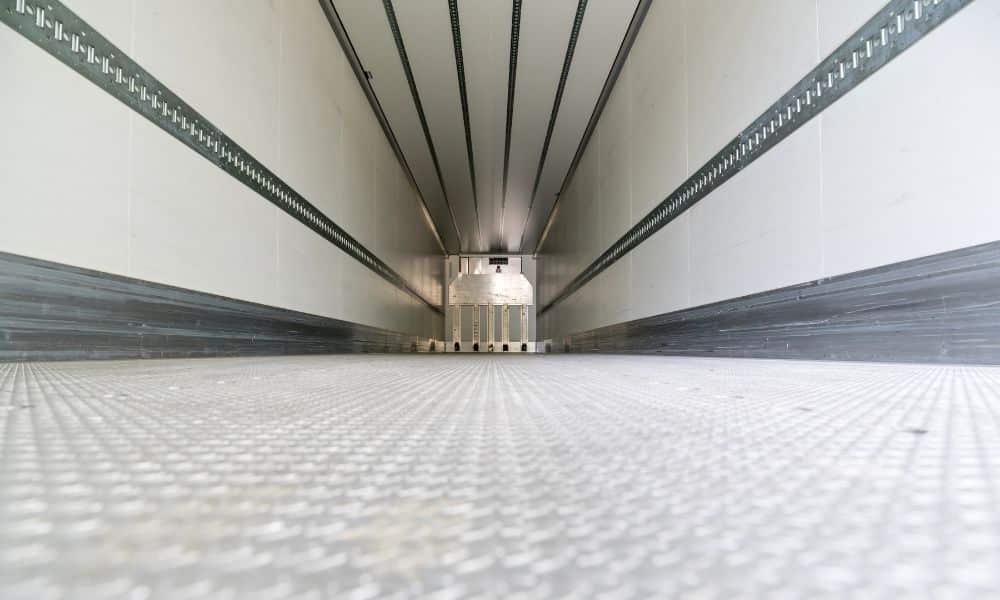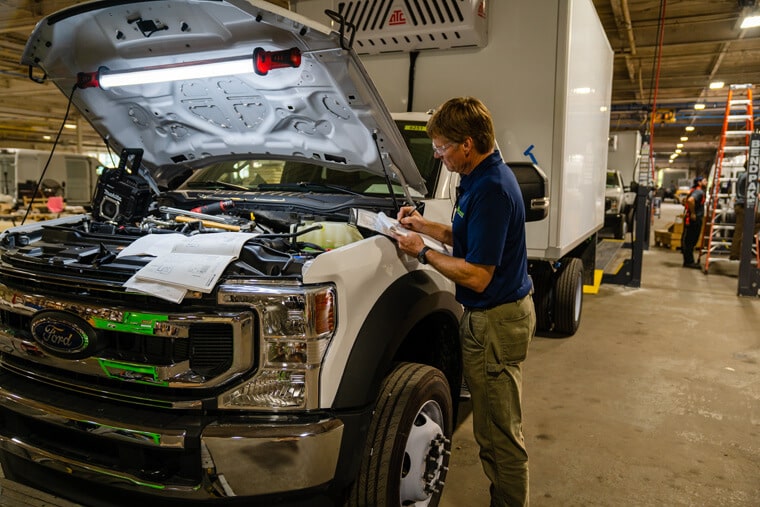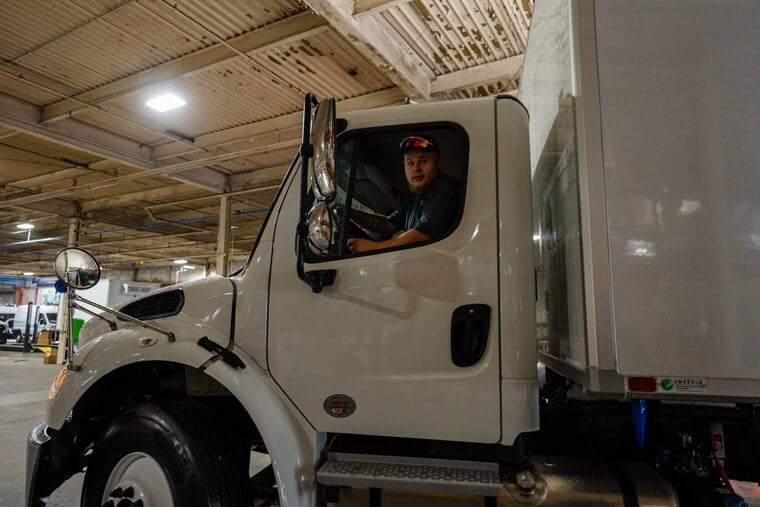
A Guide To Spec’ing Refrigerated Vehicles
Joe Dickman | September 10th, 2020
Seafood wholesalers, florists, and a large swath of the food and beverage industry all have something in common—they depend on refrigerated vehicles to ferry their products to customers.
While your company’s need for a refrigerated truck or van may be obvious, spec’ing a new vehicle (that is, determining a vehicle’s necessary specifications) is an intimidating, multistep process, especially for newcomers. It isn’t a simple matter of buying something with the capacity to carry one product shipment. You must consider the body size, refrigeration technology, chassis design, insulation amount, door type, the driver’s access to the truck, and a plethora of implements to facilitate stowing and loading/unloading.
With the goal of understanding what you’re buying, read this guide to spec’ing refrigerated vehicles.
Body Dimensions and Material
First up, you’ll need to decide on the truck or van body’s dimensions. Let your product guide you here. Utilize your packaging measurements to determine how much height, length, and width you’ll need to fit your average shipment efficiently. Too many people make the mistake of buying too big and wasting space up top rather than buying a smaller vehicle that can fit everything fine.
Buying a smaller truck costs less, but on top of that, it is more fuel efficient because of its weight, saving you money and emitting less exhaust into the environment. The body’s material also plays into how light it is. Emerald Transportation Solutions is proud to partner with PolyVan, a supplier of super-light anodized aluminum van bodies with a gross vehicle weight rating (GVWR) as low as 3.9 tons. The gas savings and environmental benefits are clear, but these lighter bodies also reduce wear on the chassis and contribute to a longer life for your truck.
Chassis
One big mistake people make is pulling the trigger on a chassis before knowing what kind of body they need. With the body locked in, use its specs to inform your chassis deliberations. First, ensure its GVWR accommodates your heaviest loads plus the body’s weight. Furthermore, the length must be long enough to hold the body comfortably. When you turn to tires, what your chassis sits on, ensure you don’t unnecessarily raise the loading platform with your selection.
Refrigeration Technology
The bread and butter of a refrigerated vehicle is, you guessed it, the refrigeration technology on board. This is another instance where knowing your product is important. The temperature threshold it must stay at dictates the cooling power of the system you buy. Body size also has a role given that it’s harder to cool a big container than a small one. As reefers get smarter, you also have a broader choice of sensors, remote control methods, blower interrupt switches, and other assistive tech.
Electric-Only and Hybrid Refrigeration
For decades, trucks have relied on engine-powered refrigeration systems. They’re still prominent, but there are electric-only and hybrid options out there as well. Electric-only systems decouple refrigeration from a running engine, allowing you to run it during stoppages. In addition, electric-powered compressors are lighter and more efficient. Meanwhile, hybrid units provide you with the flexibility to run using diesel, an electric setting, or both.
Insulation
A guide to spec’ing refrigerated vehicles isn’t complete without considering insulation. Often, this factor comes up with bodies. When buyers hear they can save money and fit everything in by cutting back on a couple of inches of insulation, they may do so. While this provides upfront savings, you risk a likely loss in the long run as container temperatures vary and refrigeration costs increase. Don’t skimp here.
One facet that should be central is what region your drivers will operate within. The US is an expansive country with several different types of climate. While most areas require a baseline layer of insulation, hot southern states demand thicker applications, perhaps made from a costlier material that will pay off in the long run.
Door Type
Next up, door type. There are two key options here: roll-up and swing doors.
Roll-Up Doors
The roll-up variety is easier to use and ideal for tight unloading conditions. They take less time to open and stow away for quick product access. What you gain in quickness, you lose in space and insulation. Roll-up doors move above your load, meaning you can’t take full advantage of the container’s space. They also aren’t as airtight as a swing door, and leak refrigerated air out and allow a bit more heat and humidity in.
Swing Doors
On the other hand, swing doors are a bit more cumbersome to use. They must swing out and remain open, restricting access from one side. If you want a railgate, swing doors make those near impossible to use. That said, they seal and insulate your product well and allow you more space than your roll-up alternative. When it comes down to it, any way to better your insulation efficiency could be a deal-breaker that leads you to a swing door.
Driver Accessibility
Let’s not ignore a vehicle’s usability. One advantage vans have is their lower profile. Drivers have no problems entering and exiting them. For the same accessibility in a truck, consider a lower chassis plus built-in steps and hand grips. These features illustrate your care for your drivers’ comfort and safety. The value for the company is a slight bump in morale as well as fewer injury-related disruptions.
Stowing and Loading
The biggest danger to your product is the loading and unloading process. Workers must maneuver thousands of pounds of varying items without causing damage. To support them, there are a number of tools at their disposal to pick from, including ramps, liftgates, and forklift reinforcement.
A Walk-Up Ramp
Walk-up ramps that pull out from the bottom of a truck’s body are utilitarian for loading and unloading by hand. They make room for dollies so workers can unload items and transport them to another cool location quickly.
Liftgates
For weightier packages, you may need a liftgate to move products to and from the container. A tuckaway gate has the benefit of being out of sight (under the truck) when stowed. For a more substantial platform, though, you’ll need a railgate. This option carries more weight and has a wider base, yet its home is on the back of the truck, which makes it an occasional obstacle.
Forklift Reinforcement
For the heaviest shipments that need a forklift, you must prepare your body’s floor with reinforced rear-end plates and other strengthening measures. Only then can it stand up to repeated forklift loading.
Emerald Transportation Solutions
Our Emerald Transportation Solutions team has experience with all these factors. We excel at supplying durable, lightweight, and innovation-driven refrigerated cargo vans, trucks, and more. Ask us about our current pricing options so you can establish or add to your fleet and enable your business to grow.
Related Articles
Contact Us
Feel Free To Contact Us If You Have Any Questions
What does under DOT mean?
Questions regarding DOT requirements come up often. 10,000 lbs GVW (gross vehicle weight) and over are commercial vehicles that fall under the Department of Transportation regulatory requirements.
What is the difference between GVW and payload?
GVW or Gross Vehicle Weight is the entire weight of the vehicle including the payload. The payload weight represents the amount of cargo you are hauling.
What is a self-powered unit and a vehicle-powered unit?
A self-powered unit has its own fuel source and will run independent of the truck. This is the heaviest and most expensive option. While vehicle-powered units run off the engine via a compressor mounted on the engine. These are less expensive and lighter in weight but you must run the truck or plug the electric standby into shore power.
What does K-factor mean and why is that important?
K-factor is a term that stands for the overall insulating value of the container (truck body). Quite simply the lower the K-factor the better the truck body will be able to maintain a given temperature and require less energy to do so.
How much lighter is a Poly Van vs a US spec body?
Poly Van bodies are very light. On average we estimate we are 75-150 lbs per foot lighter than a traditional sheet and post foamed in place body. These weight savings translates to less fuel burn and less CO2 emissions, along with added payload, the most important benefit.







